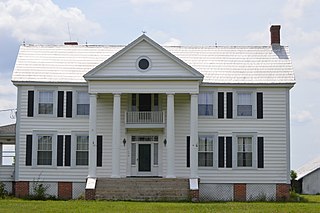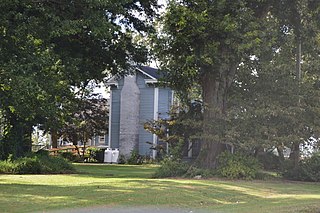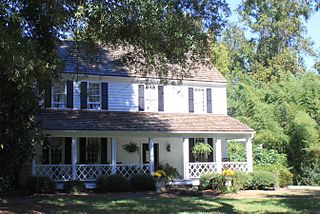The Humphrey–Williams Plantation is a historic plantation complex located near Lumberton, Robeson County, North Carolina. The Humphrey–Williams House was built about 1846 with the forced labor of enslaved people, and is a two-story, five bay, vernacular Greek Revival style frame farmhouse. It features a one-story, full-width shed porch. Also on the property are the contributing William Humphrey House, Annie Fairly's House, tobacco barn, a carriage house, a smokehouse, a store-post office (1835-1856), and the agricultural landscape.

Botany Bay Heritage Preserve & Wildlife Management Area is a state preserve on Edisto Island, South Carolina. Botany Bay Plantation was formed in the 1930s from the merger of the Colonial-era Sea Cloud Plantation and Bleak Hall Plantation. In 1977, it was bequeathed to the state as a wildlife preserve; it was opened to the public in 2008. The preserve includes a number of registered historic sites, including two listed in the National Register of Historic Places: a set of three surviving 1840s outbuildings from Bleak Hall Plantation, and the prehistoric Fig Island shell rings.
Swan Ponds is a historic plantation house located near Morganton, Burke County, North Carolina. It was built in 1848, and is a two-story, three bay, brick mansion with a low hip roof in the Greek Revival style. It features a one-story low hip-roof porch with bracketed eaves, a low pedimented central pavilion, and square columns. Swan Ponds plantation was the home of Waightstill Avery (1741–1821), an early American lawyer and soldier. His son Isaac Thomas Avery built the present Swan Ponds dwelling. Swan Ponds was the birthplace of North Carolina politician and lawyer William Waightstill Avery (1816–1864), Clarke Moulton Avery owner of Magnolia Place, and Confederate States Army officer Isaac E. Avery (1828–1863).

Quaker Meadows, also known as the McDowell House at Quaker Meadows, is a historic plantation house located near Morganton, Burke County, North Carolina. It was built about 1812, and is a two-story, four bay by two bay, Quaker plan brick structure in the Federal style. It features two one-story shed porches supported by square pillars ornamented by scroll sawn brackets. The Quaker Meadows plantation was the home of Revolutionary War figure, Col. Charles McDowell. It was at Quaker Meadows that Zebulon Baird Vance married Charles McDowell's niece, Harriet N. Espy.

William Riley Abbott House is a historic plantation house located near South Mills, Camden County, North Carolina. It was built about 1850 with the profits of the forced labor of about 40 enslaved people, and is a two-story, five-bay, Greek Revival-style frame dwelling. It has a vernacular Colonial Revival style portico that dates from the 1920s.
Buckner Hill House is a historic plantation house located near Faison, Duplin County, North Carolina. It was built about 1860, and is a two-story, five bay by five bay, square Italianate style frame dwelling with a cruciform plan. The house rests on high brick piers and is capped by a low deck-on-hip roof. It features lavish wooden and plaster ornamentation and center bay porches on each elevation. Also on the property are the contributing kitchen, smokehouse, and storehouse.

John Wesley Mallard House is a historic home located near Faison, Duplin County, North Carolina. It was built about 1886, and is a two-story, three bay by two bay, Greek Revival / Italianate style frame I-house dwelling. It features a one-story, full-width front porch with a hipped roof.

Bracebridge Hall is a part of historic farm, the house is part of a former former plantation and is a registered national historic district located near Macclesfield, Edgecombe County, North Carolina. The district encompasses eight contributing buildings, two contributing sites, and three contributing structures associated with the Bracebridge Hall. The original house was built about 1830–1832, and enlarged about 1835–1840, 1880–1881, and 1885. It is a two-story, five bay, weatherboarded frame dwelling with Greek Revival and Victorian style design elements. It features a one-story Doric order portico. Also on the property are the contributing Metal boiler/basin, Plantation Office, Servants’ House, Tobacco Barn, Troughs, Large Barn, Barn, Overseer's House, Carr Cemetery (1820), and the Agricultural landscape. Buried in the cemetery is North Carolina Governor Elias Carr (1839-1900) and his wife Eleanor Kearny Carr (1840–1912).
Massenburg Plantation, also known as Woodleaf Plantation, is a historic plantation house located near Louisburg, Franklin County, North Carolina. The property encompasses 10 contributing buildings, 1 contributing site, and 1 contributing structure. The main house reached its present form in 1838, and is a simple two-story L-shaped dwelling, with a rear two-story wing. It is four bays wide and features a stone block chimney. The property is currently owned by Travis Massenburg. The property also includes the contributing plantation office, smokehouse, cotton gin, storage building, hen house, 1+1⁄2-story Perry House bungalow, and Overseer's House ruins.
Jones–Wright House, also known as the Polly Wright House, is a historic plantation house located near Rocky Ford, Franklin County, North Carolina. It was built about 1790, and is a two-story, three bay, single pile Late Georgian style heavy timber frame dwelling. It has a low gable roof and brick end chimneys.

Elmwood Plantation is a historic plantation house located near Gatesville, Gates County, North Carolina. It was built about 1822, and is a two-story, three bay, Federal period frame building. It has a side-hall plan and a two-story, two bay, rectangular side wing. Also on the property is a gambrel-roof frame kitchen, thought to be only one of its kind in North Carolina.
Farmville Plantation is a historic plantation house located near the historic location, called Elmwood south of Statesville in Iredell County, North Carolina. It consists of two Federal style houses. The main house was built about 1818, and is a two-story, three bay by two bay, brick dwelling with a two-story entrance portico. The house is also known as the Joseph Chambers house or Darshana. The main house has a low gable roof and one-story rear shed porch. Attached to it by a breezeway is a smaller two-story, three bay by two bay stuccoed brick dwelling. The house was restored in the 1960s.

Beaver Dam Plantation House is a historic plantation house located near Davidson, Mecklenburg County, North Carolina. It was built in 1829, and is a two-story, four bay, single pile Federal style dwelling. It has gable roof, brick exterior end chimneys, and a one-story, full-width, shed roof porch. It was the home of William Lee Davidson, Jr., son of William Lee Davidson and the people he enslaved to work the plantation. It was also the site of the committee meeting of the Concord Presbytery in April 1835, during which the location of Davidson College was determined.

Waverly Plantation is a historic plantation house located near Cunningham, Person County, North Carolina. It was built about 1830, and is a Late Federal style frame dwelling consisting of a two-story, three bay by two bay main section, with an attached 1 1/2-story, one bay by two bay section. Both sections rest on brick foundations, are sheathed in weatherboard, and have gable roofs.
William E. Faison House is a historic home located near Giddensville in Sampson County, North Carolina. It was built about 1870, and is a two-story, double-pile, frame dwelling, with Greek Revival and Italianate style design elements. It has a hipped roof; one-story, gable roofed rear ell; and features a one-story front porch. Also on the property is the contributing family cemetery.
Thompson House, also known as the William Thompson House, is a historic plantation house located near Wake Forest, Wake County, North Carolina. It was built about 1853, and is a two-story, three-bay Greek Revival-style frame dwelling. It is sheathed in weatherboard, sits on a fieldstone foundation, and has four brick chimneys, two on each side. Also on the property is a contributing 1+1⁄2-story barn. The house and barn were moved to its present location in 2004.
Little Manor, also known as Mosby Hall, is a historic plantation house located in Warren County, North Carolina near the town of Littleton. It was built about 1804, and is a Federal style frame dwelling consisting of a two-story, five bay, pedimented main block flanked by one-story wings. It has a pedimented center bay front porch with Doric order pilasters and an older two-story rear wing, dated to about 1780.

William J. Hawkins House, also known as Oakley Hall, is a historic plantation house located near Ridgeway, Warren County, North Carolina. It was built about 1855, and is a two-story, three bay by two bay, Greco-Italianate style frame dwelling. It has a hipped roof with deep overhang and brackets and sits on a basement. The house's design and ornamentation reflect the influences of local builder Jacob W. Holt.
William Henry and Sarah Holderness House, also known as the Holderness-Paschal-Page House, is a historic plantation house located near Yanceyville, Caswell County, North Carolina. It was built about 1855, and is a two-story, Greek Revival style frame dwelling. It consists of a three-bay, hip roofed, main block flanked by one-story, one-bay side wings. The front facade features a pedimented one-bay Greek Revival-style porch, also found on the wing entrances. The interior features architectural woodwork by Thomas Day. Also on the property are the contributing smokehouse and carriage house.

Estate Butler's Bay, on the island of Saint Croix in the U.S. Virgin Islands, was established as a sugar plantation by 1764. It was listed on the National Register of Historic Places in 1978. The listing included five contributing buildings, a contributing structure, and five contributing sites.













